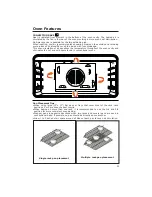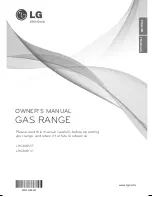
11
Electrical Requirements
Check your national and local codes regarding this unit. This range
comes equipped
with
4 ft. (121.9 cm),
4
-wire
range power
cord with grounded
4
-prong
NEMA
14-50
plug attached to unit. See “Electrical Connection” section for grounding
instructions. Must be fused seperately from any other circuit.
WARNING
ELECTRICAL SHOCK HAZARD
To avoid the risk of electrical shock, personal injury or death; verify
electrical power is turned off at the breaker box and gas supply is turned
off until the range is installed and ready to operate, installation by an
authorized installer only.
Gas Connection
The appliance must be disconnected from the gas supply piping system during any
pressure testing of that system.
The gas supply (service) line must be the same size or greater than the inlet line of
the appliance. This range uses a 1/2” (1.3 cm) IDNPT (Sch40) inlet. Sealant on all pipe
joints must be resistive to LP gas.
The range is designed specifically for natural gas or liquid propane (LP) gas. Before
beginning installation verify that the model is compatible with the intended gas supply.
Manual shut‑off valve:
This installer-supplied valve must be installed in the gas service line before the appliance
in the gas stream and in a location where it can be reached quickly in the event of an
emergency. Any opeing behind the range shall be sealed.
In Massachusetts: A “T” handle type manual valve must be installed in the gas supply
line to the appliance.
IMPORTANT: Any conversion required must be performed by your dealer or a qualified
licensed plumber or gas service company. Please provide the service person with this
manual before work begins.
Pressure Regulator
• All ranges have a pressure regulator on the incoming service line for safe and efficient
operation, since service pressure may fluctuate with local demand.
External regulators are not required on this range since a regulator is supplied with
each unit. Under no condition by-pass this regulator.
• Manifold pressure should be checked with a manometer, natural gas requires
4.0”W.C.P. and LP gas requires 11.0” W.C.P. Incoming line pressure upstream from
the regulator must be 1” W.C.P. higher than the manifold pressure in order to check
the regulator. The regulator used on this range can withstand a maximum input
pressure of 1/2” PSI (14.0” W.C.P.). If the line pressure is in excess of that amount,
a step down regulator will be required.
Electrical & Gas Requirements












































